
Treating Sprains and luxations Page Menu: 1 2 3 4 5 6 7 8 9 10 11 12 13 Next>>
Treating Sprains & Dislocations in the Golden Age of Piracy, Page 3
General Cure of Dislocations/Luxations
“The Bone luxated maketh compression on the neighbouring Parts whither it slippeth; and accordingly as those Parts are of more or less sense, so are the Pains and Accidents that attend it. You ought to hasten the returning it to its place as soon as may be. The work is purely Chirurgical, it having no dependency upon Nature, but the Extension and forcing back of the Bone into its proper feat is done by the Hands of the Artist.” (Richard Wiseman, Severall Chirurgicall Treatises, 2nd ed., 1686, p. 481)
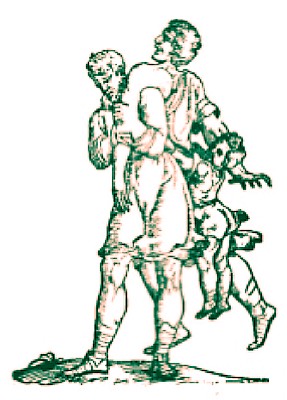
Hippocrates Method for Fixing a Dislocated Shoulder,
from Galeni Librorum Prima Clasis (1625)
The treatment of dislocations has its roots in the writings of Hippocrates who discusses a wide variety of dislocations in some detail. Some surgeons chose not to provide a template for the general cure of dislocations, offering only the method of cure for the luxations of each part. Sea surgeon John Woodall said that when it came to explaining the treatment of dislocations, he couldn't think of "words to describe ought to the purpose, which might serve at all assayes, or upon all occasions for the helpe of young men [referring here to sea surgeons assistants]"1.
However, many surgeons did define a general luxation treatment plan. French surgeon Ambroise Paré defined five steps or intentions. "The first is, of holding [the bones]; the second, of drawing or extending [the bones]; the third, of forcing in [the head of the out-of-place bone]; the fourth, of placing in convenient figure and site [securing the joint with medicines, bandages and braces]; the fifth, of correcting the concomitant, or following symptomes [administering post-operative care of the relocated bone]."2
English military surgeon Richard Wiseman, sea surgeon John Atkins and naval surgeon James Handley listed four intentions or steps for curing dislocations. Atkins notes the source of these four steps came from the writings of Polish surgeon Daniel Sennert,3 first appearing in his 1611 book Institutiones medicinae. Sennert's four steps to cure luxations as stated by Wiseman are: "1. Extension, 2. Reposition, 3. Deligation [securing the joint], 4. Collocation, or placing of the Member in a right Position."4
These same steps are repeated by Atkins, although he groups the first two steps under the heading "reduction" - putting an out of place joint back in place - and the second two steps under the heading "preventing accidents"5. Sea surgeon James Handley also repeats them, although he refers to the third step as bandaging and the fourth as "To correct or keep off accidents."6 'Bandaging' rather oversimplifies the third step as we shall see. Even though stated a bit differently, these four steps are essentially the same as Paré's intentions two through five.
Before explaining the steps that will be used in this article,
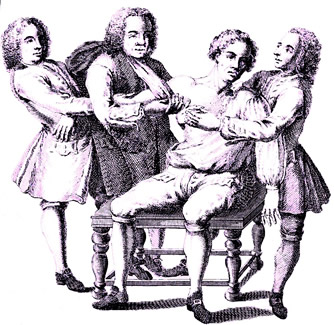
Holding the Arm for a Shoulder Extension, Plate 10, From
A General System of Surgery, By Lorenz Heister (1750)
Paré's first intention of holding the bone should be discussed. It is an odd one to include because it is necessary to hold the part to perform his second step of extension (basically pulling on) the unseated bone to move it into position to re-seat it. He provides some nice detail when explaining this step:
The whole body must be holden by the strong embracement of your servant or attendant, when as the shoulder, the vertebræ, or the thigh-bones are dislocated. But in the dislocations of the Collar-bone, elbow, hand, knee, or foot and leg, it is sufficient only to hold the part straitly [tightly] in your hands. There is necessity of holding either the body, or else some part thereof, lest, while the dislocated bone is extended...7
Still, while the importance of the way different types of luxated bones should be held to perform an effective relocation should not be underestimated, it seems this step could easily be combined with the next one which is what Wiseman, Handley and Atkins did.
1 John Woodall, the surgions mate, 1617, p. 167; 2 Ambroise Paré, The Workes of that Famous Chirurgion Ambrose Parey, 1649, p. 379; 3 John Atkins, The Navy Surgeon, 1742, p. 96:" Luxata ossa quatuor ad cam operations sunt necessariæ, Extensio. Repostio. Deligatio. Collocatio. (Sennertus.)"'; 4 Richard Wiseman, Severall Chirurgicall Treatises, 2nd ed., 1686, p. 481; 5 Atkins, p. 96; 6 James Handley, Colloquia Chyrurgica, 1705, p. 154; 7 Paré, p. 382
First Step to Fix a Dislocation/Luxation: Extend the Dislocated Joint
Extension is the first step according to Richard Wiseman, James Handley and John Atkins and the second step according to Ambroise Paré'. Wiseman says that "Extension is first required, because of the situation of the Bone, which being out of its due Socket rendreth the motion of the Muscles useless, or rather hurtful, which the more they pull the Bone, the more they distort it"1. Paré explains that the luxated bone must be pulled away from it's incorrect position so that "there may be a free space and distance between the luxated bones, by which distance the dislocated bone may the more freely be forced into its cavitie."2 However, he also points out that extension is different in each type of dislocation, depending on the strength of the part and amount of dislocation that needs to be corrected.
This is one of the only steps to be commented on by sea surgeon John Woodall. He points out that
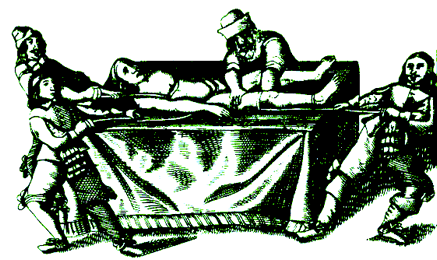
Extending The Thigh, Armamentarium chirurgicum, Johannes Scultetus, p. 58 (1665)
extension must be used in every dislocation. Woodall warns his readers that it is "to be carefully made... not on the sodaine [sudden], nor too forcible, but yet with strong and steddy hands, for in the extention exceeding [when it requires a lot of movement] great respect [is] to be taken, and it is the principall [most important] worke, yea and much Charity is to bee had [with regard to the patient] and used therein, for too farre extent [extension] weaketh much, if not overthroweth the true use of the member, even so too little extended, produceth not the effect intended"3.
Sea surgeon Atkins likewise advises:
Extension is absolutely necessary for restoring any Joint displaced.... [and] we should take Care be not made by Jirks, but smooth and strong, in Proportion to the Depth of the Cavity the Head of the Bone has slipped into, which depends on the Make of the Muscles, and the Edge or Spine of the receiving Bone, whether [it is] superficial or deep.4
Paré notes that "this work is almost always performed by the hands, which when they cannot suffice, we must use the assistance of instruments and engines"5. While he generally prefers using his hands over tables, ladders, racks and other 'instruments and engines', he wisely relies on the stronger devices when they are necessary.
1 Richard Wiseman, Severall Chirurgicall Treatises, 2nd ed., 1686, p. 481; 2 Ambroise Paré, The Workes of that Famous Chirurgion Ambrose Parey, 1649, p. 382; 3 John Woodall, the surgions mate, 1617, p. 168; 4 John Atkins, The Navy Surgeon, 1742, p. 96; 5 Paré, p. 382
Second Step to Fix a Dislocation/Luxation: Replace the Dislocated Bone
Ambroise Paré's third step and Richard Wiseman's, John Handley's and John Atkins' second step is placing the bone back into its proper place. Wiseman recommends that as soon as the bone has been extended far enough, "you are at the same instant to restore it to the place it fell from. And to do this, you must consider well the luxated Joint, and which way it slipped out; for it requireth to be returned in the same manner."1
Atkins agrees, advising the surgeon to take notice of "which Way the Head of it has lapsed, whether down, up, forward, or backward... [so that you can] direct it [back in] to the contrary Way".2 Wiseman says, "If it lie on the right Side, it must be prest back to the left: and so if it be luxated forwards, it must be forced backwards."3
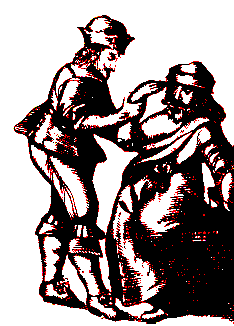
Extending An Elbow, Armamentarium
chirurgicum,
Johannes Scultetus, p. 54 (1665)
He further notes that each type of dislocation will have its own method of restoration. Paré goes even further, warning the surgeon he must "have a speciall care, that he force it no other way than into its proper cavity: for it would be dangerous, lest he should turn it from one extream into another"4.
Atkins says that when the bone has been properly aligned, "it will fly in, facilitated by the Make of the Socket"5. Paré expands on this. "We understand that the bone is set by the noise, or as it were a popp, or sound like that, which solid and sounding bodies, being fully and forcibly thrust into their cavities, do make; by the similitude & consent in figure, magnitude and all conformation of the affected part with the sound, & lastly, by the mitigation of the pain."6 John Woodall notes that once a luxation has been repaired, the repaired joint can be "compared together with the whole [undamaged] joynt, the better judgement, and truer judication might be taken" of the surgeon's success.7 Atkins likewise suggests that parity between a repaired and undamaged joint will suggest a successful operation in addition to the abatement of pain.8
Both Wiseman and Atkins end their discussion of bone replacement by discussing the difficulty of restoring a bone that has either been displaced for an extended period of time or moved quite far from its normal position. Each recommend using softening medicines before the operation in such cases. Atkins simply suggests that "it will be convenient before a Trial with Extension to use oily soft Embrocations about the Joint, to relax the Parts"9, leaving the choice of topical medicine up to the surgeon's judgement. Wiseman is a little more specific, recommending "that you first relax them [dislocated joints] by emollient Embrocations, viz. unguent. dialthææ [ointment of marsh mallows], axung. Human. [human fat] &c."10 Although human fat is not among the ingredients carried by the ship's surgeons of this time, they have Axungia Cervi (Deer Fat) and Axungia Porcina (Pork Lard) which probably would have served just as well.
1 Richard Wiseman, Severall Chirurgicall Treatises, 2nd ed., 1686, p. 481; 2 John Atkins, The Navy Surgeon, 1742, p. 96; 3 Wiseman, p. 481; 4 Ambroise Paré, The Workes of that Famous Chirurgion Ambrose Parey, 1649, p. 382; 5 Atkins, p. 96; 6 Paré, p. 382; 7 John Woodall, the surgions mate, 1617, p. 168; 8,9 Atkins, p. 96; 10 Wiseman, p. 481
Third Step to Fix a Dislocation/Luxation: Securing the Repaired Dislocation
The third step for John Handley, Richard Wiseman and John Atkins and fourth for Ambroise Paré is called deligation ('binding') which basically refers to securing the part after the dislocated bone has been replaced so that it "may be kept in its cavity, and not fly forth again."1 This step includes both medication and bandaging.
Wiseman recommends "before you make the Bandage, you ought to apply such Medicaments as have vertue to resist the Influx of Humours, and strengthen the Part"2. Wiseman advises the use of astringents [medicines that draw the tissue together], specifically recommending those he used in healing fractures.

Photo: Andy Dingley - Powdered Dragon's Blood Resin
These include: "bol. Armen. [Armenian bole or earth], sang. dracon. [dragon's blood resin], farin. volatil. [mill dust], balaust. flor. [pomegranate flowers], ros. rub. [red rose petals] cum albumine ovi [with egg white], aceto [vinegar], aut vino rub [or red wine]". (Note: commas have been added to Wiseman's quote for clarity.)
Atkins makes similar recommendations: Embrocations of Ol. Rosar. Terebinth. a. p. æ. [a mixture of equal parts oil of roses and turpentine], Ung. Dialthæ. Spt. Vini. Rect. a. p. æ. [a mixture of equal parts ointment of marsh mallows and rectified spirit of wine] Or, Ol. Cham. [oil of chamomile], Hyperic. [oil of St. John's wort] Misce. q. v. [mix at will]."3 (Commas have again been added for clarity.)
Paré is less specific in his recommendations for medicating the restored joint, suggesting "compresses steeped in rose vinegar, and spred with convenient medicines"4. Handley only advises the use of astringents.5
Several surgeons mention specific medicines to be used for patients in pain while recovering from a luxation. Wiseman says, "If there be great Pain, you may embrocate cum [with], ol. ros. [oil of roses], lumbricor. [oil of earthworms] mastichin. [oil of mastic tree resin] and apply empl. é bolo [a plaster composed of oil, litharge or elemental lead, and bole or argillaceous earth], diapalm. [diapalma plaster], de minio [red lead plaster], &c."26 (Commas have again been added.) Atkins likewise suggests Emplaster é bolo and red lead plaster, adding rupture plaster (Emplastrum ad Herniam) and yellow bees wax.6 East India Company surgeon John Woodall suggests things 'discussing [dispersing], anodine [pain relieving], and mollificative [soothing]' suggesting his reader "annoint the place with oyle of Rose, [oil of] Camomill, [oil of] Dill, or [oil of] Earth-wormes as you shall see fittest, and apply thereon a Plaster of Minium [same as Emplastrum de Minio - red lead plaster] [plaster of] diacalsiteos, Paracelsus plaster or the like"7. Sea surgeon John Moyle recommends a medicine made from ingredients already seen here: red lead and diapalma plasters mixed with oil of roses (particularly specifying it be made from unripe olives - oleum omphacine).8
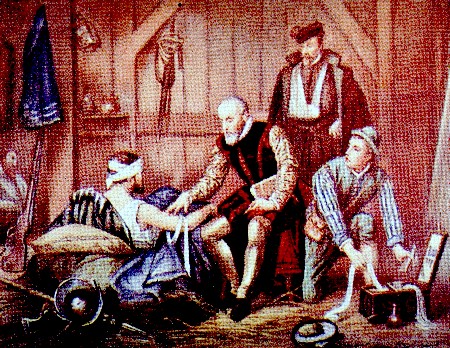
Artist: Eduoard Hamman - Ambroise Paré Bandaging a Wounded Soldier
For general bandaging of re-seated dislocations, Wiseman simply suggests to the surgeon that he "roul it on close [tight] accordingly as you see occasion."9 He probably doesn't give specifics here because the type of bandaging is dependent on the type and location of the luxation. Atkins and Paré point this out in their explanations.
Paré also advises "that the affected joint be wrapped about with stoups [stupes - pieces of cloth dipped in hot water or medicine] and clothes, or compresses"10. Atkins says, "We may only observe in general that a thick Compress of Linnen is to be under the Rowler, on that Side the Bone fell out, there being more Suspicion of its tending that Way [falling out] again."11 Paré concurs, adding that the surgeon "shall for four or five daies space meddle with nothing about the dislocation, unless pain, or some such like symptome happen."12
Woodall recommends that that the surgeon "rowle and binde up the member artificially [as opposed to letting nature take over] as shall be most fit"13. Atkins similarly recommends "Bandages and Covering should be soft and smooth"14, probably so they are comfortable for the patient to lay on.
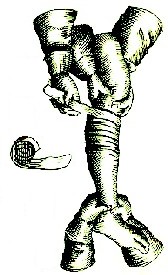
Proper Tight Bandaging, From
l'Arcenal de chirurgery, Johann
Scultetus, p.106 (1665)
In his discussion of deligation, Atkins also refers his readers to French surgeon Charles Gabriel Le Clerc's book A description of bandages and dressings which deals exclusively with bandaging of a wide variety of wounds. Le Clerc offers some additional comments on the general bandaging of restored luxations.
He advises surgeons that "the Rolling ought to be straight [tight], to keep the Bones in their situation, when they are reduced, and yet not so as to hinder the Circulation, for then the Part will be defrauded of its Nourishment, and there will be danger of a Mortification."15 He further warns that "the Bandage of any Limb is too streight [tight], when the Veins beyond are exceedingly swoln, and in this Case the Dressings must be taken off and made anew."16 On the other hand, Le Clerc advises "If after the Bandage there be no rising of the neighbouring part, and the Patient complains of nothing, and is very easy, the Dressing is too slack and must be taken off, for however the Patient ought not to suffer much Pain when the Part is bound up, yet he ought to feel some, and not be altogether at his ease."17
Paré mentions one other facet not discussed by the other authors in general bandaging of luxations, most likely because it is specific to certain dislocations. He suggests that "if the arm be dislocated, it shall be carried bound up in a scarf: if the thigh, knee, leg, or foot be luxated, they shall be fitly laid in a bed"18. These things are clearly done to prevent putting undue pressure on a healing dislocation to prevent it from coming back out while the surrounding muscles, tendons and tissues are still weak.
1 Ambroise Paré, The Workes of that Famous Chirurgion Ambrose Parey, 1649, p. 382; 2 Richard Wiseman, Severall Chirurgicall Treatises, 2nd ed., 1686, p. 481; 3 John Atkins, The Navy Surgeon, 1742, p. 95; 4 Paré, p. 382; 5 James Handley, Colloquia Chyrurgica, 1705, p. 154; 6 Wiseman, p. 481; 7 John Woodall, the surgions mate, 1617, p. 169; 8 John Moyle, Chirugius Marinus: Or, The Sea Chirurgeon, 1693, p. 12; 9 Wiseman, p. 481; 10 Paré, p. 382; 11 Atkins, p. 96; 12 Paré, p. 382; 13 Woodall, p. 169; 14 Atkins, p. 96; 15,16 Charles Gabriel Le Clerc, A description of bandages and dressings, 1701, p. 4; 17 Le Clerc, p. 5; 18 Paré, p. 382
Fourth Step to Fix a Dislocation/Luxation: Post-Operative Care
The final intention involves collocation ('putting things into position'), which refers here to post-operative care. Richard Wiseman defines collocation as "placing of the Member; and that ought, for the ease of the Patient, to lie soft, and somewhat raised up,
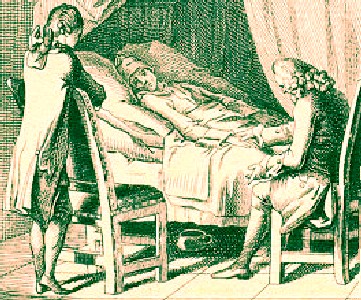
Resting Easy, From Elementarwerke fur die Jugend und ihre
Freunde,
p. 37 (1774)
neither much extended, nor too much bent, a middle figure being best to prevent Pain."40 This is an elaborate way of calling for what Ambroise Paré refers to as "cessation and rest, which is, to correct the symptomes and complicate affections, as pain, inflammation, a wound, fracture, and others"2. Post-operative care is key to preventing undesirable complications while healing.
Part of this involved doing nothing. Wiseman advises, "If no Accident [complication] happen, you must not dress it again till the seventh day"3. Sea surgeon John Atkins recommends a rest for dislocations of the arms and legs. "In the inferior Limbs [lower parts of the arm and leg], a little Elevation, and a confined quiet Posture for a Fortnight or three Weeks: And if the superior Limbs [upper parts of the arm and leg], they should be so slung and sustained, as that no succombing Weight, of the Parts below, incommode it."4
Wiseman suggests rehabilitation exercises once the repaired joint has rested. He says the surgeon "may alter the Position, and move the Joint a little to and fro, and dress it up with such Medicaments as may give a breathing to the Humour [humors were thought to descend on wounded parts and inhibit healing], and corroborate the weak Joint."5
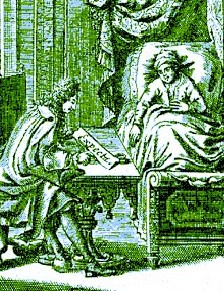
Prescribing Medicines, From Ars sanandi cum
expectalione,
by Georg Ernst Stahl (1730)
The medications which were discussed in the previous step would continue to be applied to the damaged joint as long as the surgeon felt they were necessary. Wiseman adds medications which can be used if the bandaged part itches. His suggests bathing it in salt water, something that would have been freely available to sea surgeons. Failing that, he advised "Decoction ex summitat. absinth. [the tops of wormwood] flor. cham. [chamomile flowers] ros. rub. [red rose petals] balaust.[pomegranate flowers] bacc. myrtil.[myrtle berries] juniperi. [juniper berries], nuc. cupressi [cypress nuts], &.c. to which may be added spir. vini. [spirit of wine]"6. He also warns that "greasie Applications relax the Tendon, and prolong the Cure."7
A few other suggestions for post-operative care were given by sea surgeons. John Woodall advised that when the surgeon feared complications, "thou maist also give the partie some laxative."8 This is likely intended to purge unwanted humors from the system to prevent the feared complications. In a similar vein, Atkins recommended "a proper Restraint in Diet [be] prescribed, Venesection [bloodletting - to remove unwanted or corrupted humors], sometimes Clysters [enemas - again, to purge unwanted humors] and cooling Emulsions [milky liquid extracted from seeds, usually having a relaxing quality]."9 'Cooling' here refers to the humoral properties of the medicines. Cooling medicines were used for health problems that were believed to have a hot nature. A full explanation of this concept can be found on this page of the Dispensatory article.
1 Richard Wiseman, Severall Chirurgicall Treatises, 2nd ed., 1686, p. 481; 2 Ambroise Paré, The Workes of that Famous Chirurgion Ambrose Parey, 1649, p. 382; 3 Wiseman, p. 481; 4 John Atkins, The Navy Surgeon, 1742, p. 96; 5,6,7 Wiseman, p. 481; 8 John Woodall, the surgions mate, 1617, p.169; 9 Atkins, p. 97

